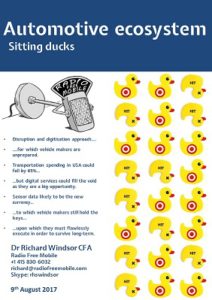August 9th 2017: Radio Free Mobile deepens its coverage of digital ecosystems with the publication of: Automotive Ecosystem – Sitting ducks.
RFM research subscribers will receive their copy directly by email.
Click here for a sample and here for purchase options
Transport is the next industry to be digitised and almost all vehicle makers are unprepared. Electric Vehicles (EVs) and autonomy could reduce overall USA transport spending by 65% which needs to be supplemented with digital services by players wishing to survive. RFM thinks that sensor data is the one area where vehicle makers have an edge and hence, is critical to their future. They must control this asset or face becoming sitting ducks for those that would reduce them to handsets on wheels.
- Digital differentiation. Transport is ripe for disruption. Furthermore, there is a real possibility that demand for vehicle shipments falls substantially over the next 10-15 years. RFM thinks that embracing digital, controlling sensor data combined with a completely new way of thinking is required by vehicle makers wishing to survive for the long-term.
- Sensor data will be the new vehicular currency. RFM thinks that Digital Life services from smartphones will become ubiquitous and unlikely to offer value for vehicle makers. However, sensor data is unique, required for autonomy and critically, they still have a lock on access to it. RFM sees sensor data as the opportunity for vehicle makers to avoid severe disruption.
- The infotainment unit could become the most important part of the vehicle as it is where all the sensor data can be accessed in one place. Furthermore, it is the main digital interface with the user meaning that the digital user experience will be defined here.
- The gatekeepers. Despite the threat, RFM believes that the fact that OEMs are the gatekeepers to sensor data will give them a seat at the table as well as the opportunity to differentiate. How they execute on this is likely to define who survives and who does not.
- Monetisation. RFM calculates that Digital Life (smartphone only) in the vehicle could be worth $112 per user per year in USA or $32.1bn in revenues. The use of sensor data could drive that figure higher. Potential substantial falls in both the radio advertising ($17.7bn) market and transportation ($2.6tn) market provide a plentiful source for spending on new digital services.
- EVs and autonomy have the capacity to cause substantial declines in both vehicle shipments and transport spending as a whole. RFM calculates that manual EVs could reduce cost per mile to $0.40 per mile from $0.88 where it is today. Autonomy promises to reduce this still further to $0.29 per mile. There is huge economic incentive for consumers to switch to EVs which together with autonomy, could cause a 44% reduction in USA vehicle shipments.
- Sitting ducks. While vehicle makers are aware of the threat, many are in denial and few have any real idea how to address it. Most are easy targets for those that would reduce them to handsets on wheels.










Blog Comments
Victor
August 11, 2017 at 9:17 am
Interestingly, this is one category that doesn’t look to be disrupted – all of the old established businesses that would be targets for disruption are developing their own EV and self-driving technology. Vehicle makers are not sitting ducks, they have been fastidiously developing their EV and sensor tech, whether it’s GM, BMW, or Volvo, who have set a near term goal to only sell EV.
In years past, cars were reduced to rolling entertainment systems, and car manufacturers ceded the infotainment space by delivering dreadful center stacks for years. This is why CarPlay and to a lesser extent Android Auto were able to gain the traction they have: the car manufacturers failed abysmally. Currently, there are hooks in CarPlay that allow manufacturers to expose telematics for the car as just another app on in the interface. GM pushed for this.
Demand for vehicle shipments can fall if the idea of private ownership as a necessity changes, especially when cars can be summoned on demand.
We know that customers see autonomy not as an upsold option, but as a feature that must come standard. It’s unsurprising that autonomy represents greater efficiency. The same was true of manual and automatic transmissions in the last few decades: having a computer shift was more efficient than a human working a clutch or paddles.
Other big changes: the drop in organ donation as accidents fall, and in the US, road use taxes that are built into petrol tax. There’s already arguments over how to charge EVs for causing wear to the roads when they don’t pay the tax at the gas pump. When the number of vehicles sold drops in addition, the revenue raised will be less, causing tense moments at legislatures around how to fund repairs to the asphalt.
By developing their own self-driving sensor and intelligence, by developing and committing to EV as a platform, the OEMs are avoiding disruption as we normally speak of it. They aren’t being blindsided. What isn’t at all decided is the outcome.